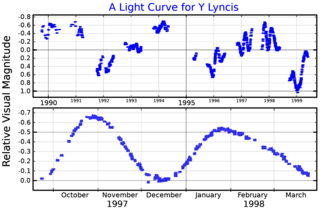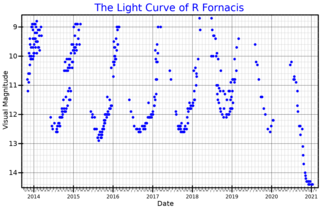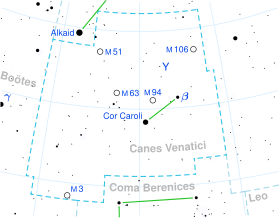
Red supergiants (RSGs) are stars with a supergiant luminosity class and a stellar classification K or M. They are the largest stars in the universe in terms of volume, although they are not the most massive or luminous. Betelgeuse and Antares A are the brightest and best known red supergiants (RSGs), indeed the only first magnitude red supergiant stars.

The asymptotic giant branch (AGB) is a region of the Hertzsprung–Russell diagram populated by evolved cool luminous stars. This is a period of stellar evolution undertaken by all low- to intermediate-mass stars (about 0.5 to 8 solar masses) late in their lives.

The red-giant branch (RGB), sometimes called the first giant branch, is the portion of the giant branch before helium ignition occurs in the course of stellar evolution. It is a stage that follows the main sequence for low- to intermediate-mass stars. Red-giant-branch stars have an inert helium core surrounded by a shell of hydrogen fusing via the CNO cycle. They are K- and M-class stars much larger and more luminous than main-sequence stars of the same temperature.

R Coronae Borealis is a low-mass yellow supergiant star in the constellation of Corona Borealis. It is the prototype of the R Coronae Borealis variable of variable stars, which fade by several magnitudes at irregular intervals. R Coronae Borealis itself normally shines at approximately magnitude 6, just about visible to the naked eye, but at intervals of several months to many years fades to as faint as 15th magnitude. Over successive months it then gradually returns to its normal brightness, giving it the nickname "reverse nova", after the more common type of star which rapidly increases in brightness before fading.

Mu Cephei, also known as Herschel's Garnet Star, Erakis, or HD 206936, is a red supergiant or hypergiant star in the constellation Cepheus. It appears garnet red and is located at the edge of the IC 1396 nebula. Since 1943, the spectrum of this star has served as a spectral standard by which other stars are classified.

R Centauri is a Mira variable star in the constellation Centaurus.

Phi Persei is a class B2Vep fourth-magnitude star in the constellation Perseus, location about 720 light-years from Earth.

R Andromedae is a Mira-type variable star in the constellation Andromeda. Its spectral class is type S because it shows absorption bands of zirconium monoxide (ZrO) in its spectrum. It was among the stars found by Paul Merrill to show absorption lines of the unstable element technetium, establishing that nucleosynthesis must be occurring in stars. The SH molecule was found for the first time outside earth in the atmosphere of this star. The star is losing mass due to stellar winds at a rate of 1.09×10−6M☉/yr.
HD 30442 is a solitary star in the northern circumpolar constellation Camelopardalis. It is faintly visible to the naked eye with an apparent magnitude of 5.47 and is estimated to be 403 light years away from the Solar System. The object has a heliocentric radial velocity of −37 km/s, indicating that it is drifting closer.

TX Piscium is a variable red giant star in the constellation Pisces. It is amongst the reddest naked eye stars, with a significant reddish hue when seen in binoculars. It is approximately 800 light years from Earth.

A red giant is a luminous giant star of low or intermediate mass in a late phase of stellar evolution. The outer atmosphere is inflated and tenuous, making the radius large and the surface temperature around 5,000 K or lower. The appearance of the red giant is from yellow-white to reddish-orange, including the spectral types K and M, sometimes G, but also class S stars and most carbon stars.
HD 85951, formally named Felis, is a solitary orange hued star in the constellation Hydra. It has an apparent magnitude of 4.94, making it faintly visible to the naked eye under ideal conditions. Based on parallax measurements, the object is about 570 light-years away from the Sun and is receding with a heliocentric radial velocity of 50 km/s.

UY Scuti (BD-12°5055) is a red supergiant star in the constellation Scutum. It is considered to be possibly one of the largest known stars and is also a pulsating variable star, with a maximum brightness of magnitude 8.29 and a minimum of magnitude 10.56. It has an estimated radius of 909 solar radii thus a volume of 750 million times that of the Sun. This estimate implies if it were placed at the center of the Solar System, its photosphere would extend past the orbit of Mars.

Y Lyncis is a semiregular variable star in the constellation Lynx. It is an asymptotic giant branch star of spectral type M6S, with a luminosity class of Ib, indicating a supergiant luminosity. It is around 1,160 light years away.

IK Tauri or NML Tauri is a Mira variable star located about 280 parsecs (910 ly) from the Sun in the zodiac constellation of Taurus.

R Fornacis is a Mira variable and carbon star located in the constellation Fornax. It is around 1,800 light years away based on parallax measurements.

GP Comae Berenices, abbreviated to GP Com and also known as G 61-29, is a star system composed of a white dwarf orbited by a planetary mass object, likely the highly eroded core of another white dwarf star. The white dwarf is slowly accreting material from its satellite at a rate of (3.5±0.5)×10−11 M☉/year and was proven to be a low-activity AM CVn star. The star system is showing signs of a high abundance of ionized nitrogen from the accretion disk around the primary.

Y Tauri is a carbon star located in the constellation Taurus. Parallax measurements by Gaia put it at a distance of approximately 2,170 light-years.

EP Aquarii is a semiregular variable star in the equatorial constellation of Aquarius. At its peak brightness, visual magnitude 6.37, it might be faintly visible to the unaided eye under ideal observing conditions. A cool red giant on the asymptotic giant branch (AGB), its visible light brightness varies by about 1/2 magnitude over a period of 55 days. EP Aquarii has a complex circumstellar envelope (CSE), which has been the subject of numerous studies.
HD 193373 is a solitary red hued star located in the equatorial constellation Delphinus. It has an apparent magnitude of 6.21, placing it near the limit for naked eye visibility. Parallax measurements place it 846 light years distant and it is currently receding with a heliocentric radial velocity of 22.7 km/s.


















